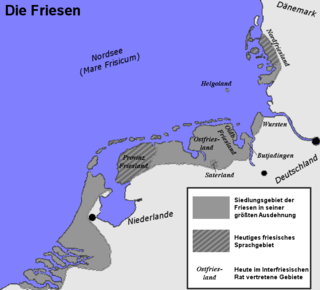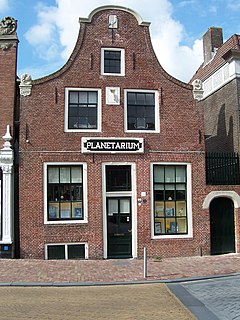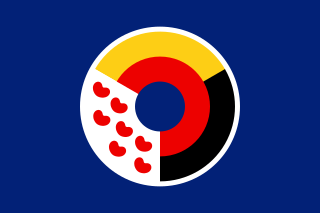
Friesland, historically known as Frisia, is a province of the Netherlands located in the country's northern part. It is situated west of Groningen, northwest of Drenthe and Overijssel, north of Flevoland, northeast of North Holland, and south of the Wadden Sea. As of January 2020, the province had a population of 649,944 and a total area of 5,749 km2 (2,220 sq mi).

The Frisians are a Germanic ethnic group indigenous to the coastal regions of the Netherlands and northwestern Germany. They inhabit an area known as Frisia and are concentrated in the Dutch provinces of Friesland and Groningen and, in Germany, East Frisia and North Frisia. The Frisian languages are spoken by more than 500,000 people; West Frisian is officially recognised in the Netherlands, and North Frisian and Saterland Frisian are recognised as regional languages in Germany.

Leeuwarden is a city and municipality in Friesland, Netherlands. It is the provincial capital and seat of the Provincial Council of Friesland. In 2019, the municipality had a population of 123,107.

West Frisian, or simply Frisian, is a West Germanic language spoken mostly in the province of Friesland in the north of the Netherlands, mostly by those of Frisian ancestry. It is the most widely spoken of the Frisian languages.

Eise Jeltes Eisinga was a Frisian amateur astronomer who built the Eise Eisinga Planetarium in his house in Franeker, Dutch Republic. The orrery still exists and is the oldest functioning planetarium in the world.

Franeker is one of the eleven historical cities of Friesland and capital of the municipality of Waadhoeke. It is located north of the Van Harinxmakanaal and about 20 km west of Leeuwarden. As of 1 January 2014, it had 12,781 inhabitants. The Eise Eisinga Planetarium, established in 1781, is located in the city.

The Frisian National Party is a Frisian nationalist political party in the Netherlands. The FNP is mostly involved in Frisian politics. The Independent Senate Group represents the FNP on a national level, the EFA represents the FNP on a European level.

Boazum is a Frisian village in the municipality of Súdwest-Fryslân, Netherlands with an approximate population of 397 in January 2017. The Boazum church is an example of romanesque twelfth-century architecture and possesses an Ottonian fresco portraying a beardless Christ.
A grietman is partly a forerunner of the current rural mayor in the province of Friesland, and partly the forerunner of a judge. The area of jurisdiction was the municipality or gemeente. In the judge function, the concept was also found in the Western side of the province of Groningen.

The Royal Eise Eisinga Planetarium is an 18th-century orrery in Franeker, Friesland, Netherlands. It is currently a museum and open to the public. The orrery has been on the top 100 Dutch heritage sites list since 1990 and in December 2011 was placed on a provisionary list of future UNESCO World Heritage Site candidates. It is the oldest working orrery in the world.

Eeltsje Hiddes Halbertsma was a Frisian writer, poet and physician, and the youngest of the Halbertsma Brothers. He became well known when he and his elder brother Justus published the poetry and short story collection De Lapekoer fan Gabe Skroar in 1822. Afterwards, this work was continually expanded, and also came to include contributions by a third brother, Tsjalling, until all the Halbertsma Brothers' prose and poetry was posthumously collected in 1871 to become the famous work Rimen en Teltsjes. This book played a role of crucial importance in the development of a new literary tradition after Western Frisian had been used almost exclusively as a spoken language for three centuries. Of the three Brothers Halbertsma, Eeltsje was probably the most talented, en his poetry especially is still very much admired. His oeuvre included the poem De Alde Friezen, which later became the national anthem of the Western Frisian people.

De Fryske Marren is a municipality of Friesland in the northern Netherlands. It was established 1 January 2014 and consists of the former municipalities of Gaasterlân-Sleat, Lemsterland, Skarsterlân and parts of Boarnsterhim, all four of which were dissolved on the same day. The municipality is located in the province of Friesland, in the north of the Netherlands, and has a population of 51,430 and a combined area of 559.93 km2 (216.19 sq mi).
Abe de Vries is a Frisian poet, essayist, literary critic, journalist, editor, translator, photographer, and one of the Frisian public figures leading the cultural and intellectual debate in Friesland.
Eelco Alta was a Frisian clergyman, theologian, and veterinarian.

The Interfrisian Council is a geopolitical organization that represents the common interests of the Frisians. The organization consists of three regional councils or "sections": North Frisia, East Frisia and West Frisia. Every three years, the presidency of the Interfrisian Council is handed over to another section. The council was established in 1956.

Justus Hiddes Halbertsma, West Frisian form: Joast Hiddes Halbertsma, pron. [jo.ǝst ˈhɪdəs ˈhɔlbǝtsma] ; Dutch form: Joost Hiddes Halbertsma, pron. [joːst ˈhɪdəs ˈhalbǝrtsma], was a Frisian writer, poet, minister, lexicographer and linguist. Today, he is primarily known for the poetry and short story collection De Lapekoer fan Gabe Skroar, which he wrote with his brother Eeltsje, publishing the first edition in 1822. Afterwards, this work was continually expanded, and also came to include contributions by a third brother, Tsjalling, until all the Halbertsma Brothers' prose and poetry was posthumously collected in 1871 to become the famous work Rimen en Teltsjes. Although the literary value of this collection was later disputed by some critics, it is undeniable that Rimen en Teltsjes played a role of crucial importance in the development of a new literary tradition after Western Frisian had been used almost exclusively as a spoken language for three centuries.

Tsjalling Hiddes Halbertsma, was Dutch Frisian writer, poet and merchant, and the least well-known of the three Brothers Halbertsma. During his life he won a certain amount of fame in and around Grou, for the poems and short stories he wrote, and also because of his success as a businessman. After his death some of his literary works were collected with those of his brothers Justus and Eeltsje to be published in 1871 as the famous Rimen en Teltsjes. It was only from 1918 onwards that more of Tsjalling Halbertsma's works were added to this collection.

Waadhoeke is a municipality of Friesland in the northern Netherlands. It was established 1 January 2018 and consists of the former municipalities of Franekeradeel, het Bildt, Menameradiel and parts of Littenseradiel, all four of which were dissolved on the same day.

Noardeast-Fryslân is a municipality of Friesland in the northern Netherlands. It was established 1 January 2019 and consists of the former municipalities of Dongeradeel, Ferwerderadiel and Kollumerland en Nieuwkruisland, all three of which dissolved on the same day.

The Dairy Campus in the Netherlands is a test farm and centre for scientific research and practical training in the field of dairy farming, located, the capital of the province of Friesland. The decision to launch this centre was made in 2011, and it was opened in 2016. The Campus traces its roots to the test farm Bosma Zathe, founded in Ureterp in 1944; its building complex was formerly called Nij Bosma Zathe. Today, the Dairy Campus is part of Wageningen University & Research (WUR). All activities in the centre are focused on the development of sustainable methods for the production and processing of dairy products.
























































